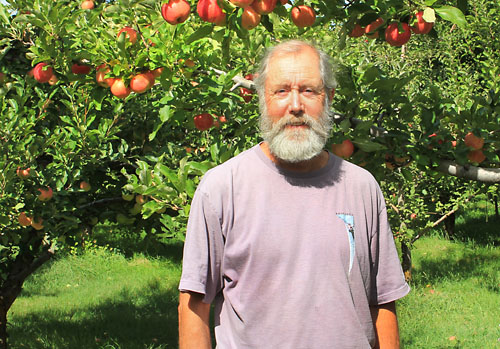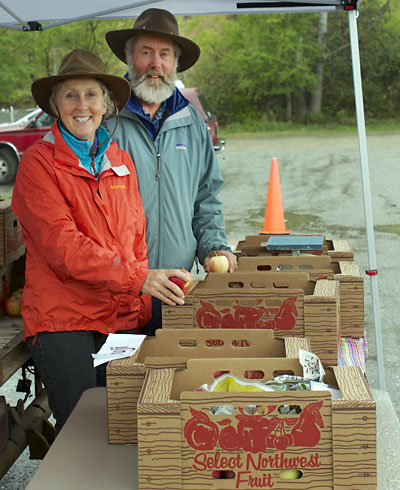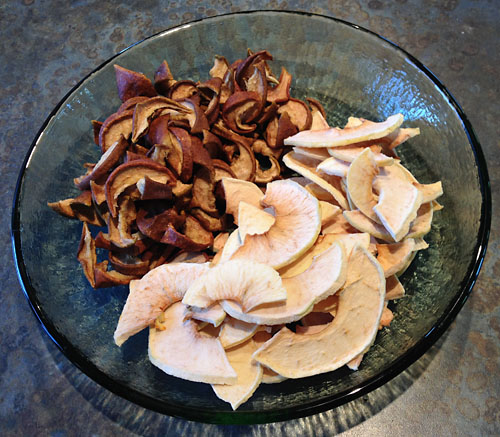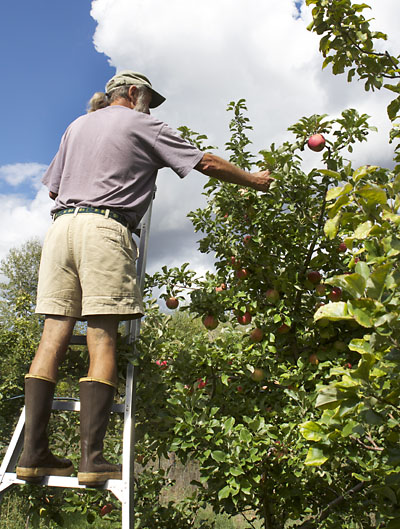home | internet service | web design | business directory | bulletin board | advertise | events calendar | contact | weather | cams

|
 Richard Murray literally surrounded by the fruits of his labor. Richard Murray literally surrounded by the fruits of his labor.PART SEVEN OF A SERIES Methow Valley orchardists have had a tough year. First there was the freeze the night of April 24, when the mercury dipped to 23 degrees on the sunny bench that is home to Twisp River Organic Apples. Richard Murray lost 70 percent of this year’s fruit crop that night when the blossom buds on his trees froze. The irrigation ditch hadn’t been turned on yet, he explains, so the only sprinklers he could run to protect his trees were the few he hooked up to a hose connected to a frost-free hydrant. Summer brought plenty of rain and heat. In fact, Murray says he was picking fruit about one week earlier than last year. Then came the September 15 thunderstorm with gusty winds and heavy rain that struck just when many apples and pears were almost ready to pick. Walking through the orchard on the warm, sunny morning after that storm Murray found more windfall than expected. “It must have blown more than 20 [mph] last night to have this much fruit on the ground,” he says. “We have a lot of applesauce to make this afternoon.” Fast forward two weeks to Richard and Jocelyn Murrays’ smiling faces at the Saturday Farmers’ Market in Twisp. A steady rain is dripping off the canopy under which they are selling apples. Market and vendor attendance obviously is down but the Murrays’ enthusiasm is intact.  Richard and Jocelyn Murray sell their fruit at the Farmers Market in Twisp and at local stores. They also donate a portion of their harvest to The Cove food bank and Red Shed teen cooking program. Richard and Jocelyn Murray sell their fruit at the Farmers Market in Twisp and at local stores. They also donate a portion of their harvest to The Cove food bank and Red Shed teen cooking program.Autumn is the retail high season for apple and pear growers. The Murrays help customers select apples for immediate use or to store for winter, to cook with or tuck into school lunches. They advise on crunch and flavor—sweet or tart. If you yearn to know the history of any given variety, Richard’s your man. The Murray orchard is a “labor of love” that provides the couple supplemental income. Richard, 64, and about five years into retirement from the Forest Service, grows 28 varieties of apples and five kinds of pears on the 280 trees he’s planted on one acre of a 20-acre “road to river” property the couple owns up the Twisp River. Jocelyn, a nurse specializing in maternity and pre-natal care, retired from the Methow Valley Family Practice clinic in Twisp a year ago. She pitches in wherever she’s needed in the orchard, but regularly helps with irrigation and “has the eye for sorting” fruit, says Richard. Richard is a native of Maryland who studied forestry in California. He joined the Navy during the Vietnam War, and later worked for the U.S. Forest Service and National Park Service in Alaska. He came to the Methow with his previous partner in the late 1970s and worked in the local backcountry until he retired from the Forest Service. For the past 15 or 16 years, he’s worked part-time as needed on a wildfire incident management team. His journey to becoming an organic apple orchardist started more than 20 years ago when he worked in an orchard that used “integrated spray practices.” He says that within 5 or 10 minutes he developed a headache—“the first sign of poisoning.” At some point he decided to plant his own orchard. Among the old-timers he sought out for advice were Vernon and Beulah LaMotte, both of whom were raised in the Methow. “Get the hardiest of everything,” the LaMottes advised. They had older varieties of apples on their land from which he took scions to graft to his own rootstock. Richard says he asked the couple questions like “What are your favorite apples?” and “What grows here?”  Dried Seckel pears and Gingergold apples from the Murray orchard. Gingergolds are ripe in early fall, have good flavor and store well. Dried Seckel pears and Gingergold apples from the Murray orchard. Gingergolds are ripe in early fall, have good flavor and store well.Valley settlers often planted fruit trees for family use, although commercial orchards were planted in the Methow as early as 1890. A prolonged drought in the early 1900s and the freeze of 1968, when the coldest temperatures ever recorded in Washington state set a new record, were devastating for local orchardists. The official low was minus 48 degrees Fahrenheit. “We’re at the mercy of everything,” Richard says of farmers. “It took me 16 years to get established,” he notes. He planted 40 trees one year and 30 the next. His goals were to be organic and take advantage of varieties that taste good and thrive in the local climate. “I don’t think I really intended to plant 280 trees,” he remarks. However, one fascination led to another as he learned from other fruit growers and his own research and he started experimenting. He learned, for example, that one of the hardiest local apple trees was the yellow transparent. It provides the rootstock for 80 of his trees, including “two trees that survived the ’68 freeze.” He has grafted many varieties onto his rootstock. He has one tree that produces eight varieties of apples and a pear tree with at least four varieties of pears hanging from its limbs. “The cool thing about having all these varieties is that people can find a variety they like and get them again the next year,” he says. But asking Richard to name his favorite apple is like asking him to pick a favorite child. He knows the history of each variety, it’s desirable properties and it’s weaknesses. He likes apples that have good flavor and are firm but not too crunchy, such as the Gingergolds, an early fall variety. The mid-fall Jonamacs and tree-ripened Galas also make his list of favorites. They all taste good and store well, he adds. One of the most popular apples these days is the Honeycrisp, Richard says. The patent on the variety has expired and North Central Washington has a good climate for growing it. Regional commercial growers are converting some of their acreage to Honeycrisps, he adds. Jocelyn says her favorites are the Spitzenburgs, said to be Thomas Jefferson’s favorite apple, and the NY429, a creation of the Cornell University agriculture department, which crossed an Empire with a Schoharie Spy to produce it.  Richard Murray climbs a ladder to pick a Honeycrisp apple, one of the Richard Murray climbs a ladder to pick a Honeycrisp apple, one of themost commercially popular varieties today. His are tree ripened and sold at the Farmers Market the day after they are picked. The new official name of the NY429 is Fortune, but the Murrays aren’t going there because as Jocelyn says, “We have customers who ask for ‘those number apples.’ ” Jocelyn is a native of Delaware who thought she’d become a botanist until she had the first of two children—a daughter born to her and her then-husband while they were homesteading in northern British Columbia’s Peace River Valley. It was not an easy life, she adds. “You had to be young and unencumbered [by children],” she says. The couple sold their property and moved to the Methow Valley. By then Jocelyn had decided to pursue a nursing degree. She completed Everett Community College’s three-year program and spent six years commuting over the Loup to work a swing shift at the hospital in Omak. “I felt like I paid a price to stay in the Methow Valley,” she says. “It was worth it.” Divorced, she married Richard in 1999. He became dad to her two children and considers them his own. But it is future transitions that are on the Murrays’ minds these days. What will happen to their orchard when they can no longer work it? Richard finds his aging shoulders are starting to balk at long hours on a ladder. And he wants to continue to hike as long as he possibly can. (He is one of the “trail angels” who befriend through hikers on the Pacific Crest Trail.) He says he and Jocelyn agree that they want to find a way to guarantee that at least two more generations—their children and grandchildren—will have the option of farming the land. “We want to keep it in agriculture,” he says. This year, “three young people who are learning about agriculture” have been working at the orchard in exchange for food, he adds. Whatever the future holds, there’s no mistaking the satisfaction Richard finds in his orchard. He talks about the pleasure of listening to returning birds in the spring while he stands on the snow pruning trees. He expresses satisfaction at finding solutions to challenges such as getting a flock of 50 bothersome crows to take flight by shooting a .22 into the nearby ground. Only once in 20 years has a meddlesome bear inspired him to buy a tag to hunt it. Yet his game camera shows bears regularly eat fruit from trees outside the orchard fence. “We don’t go out in the orchard after dark,” he confesses. As for the yellow jackets and wasps, he says they don’t bother people because they find enough fruit on the ground to stay happy. And when bald-faced hornets built a nest in one of his Jonamac trees this year, he simply festooned it with bright yellow caution tape to warn the humans out of their space. 10/3/2013 Comments
|
